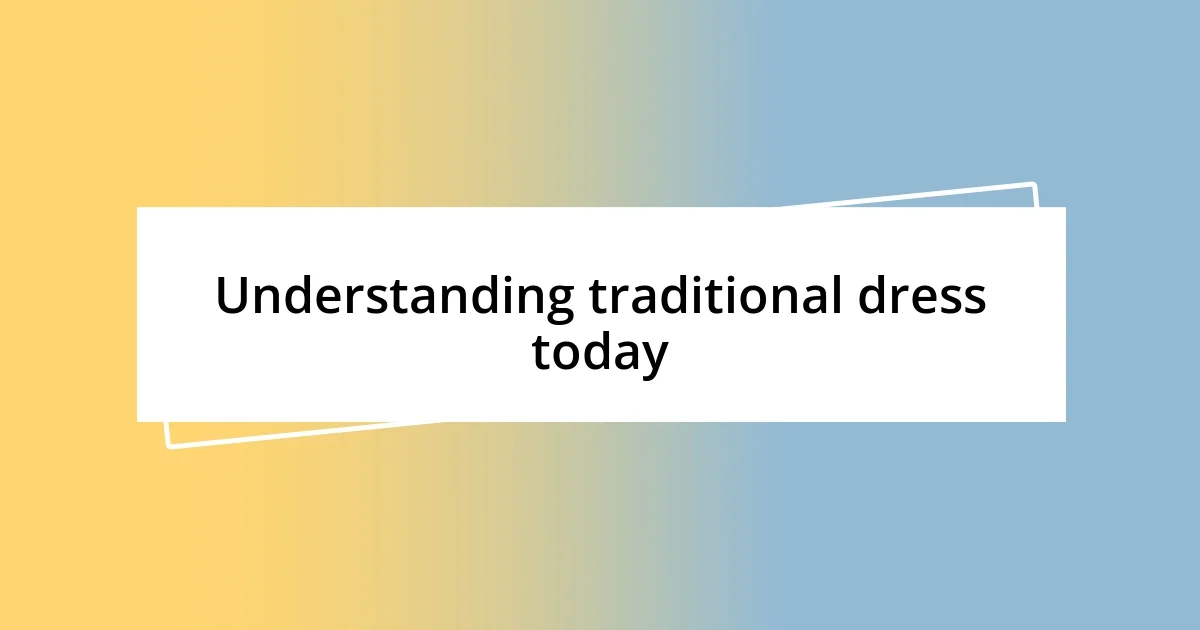Key takeaways:
- Traditional dress serves as a powerful connection to cultural heritage, evoking pride and fostering conversations about identity.
- Modern influences such as sustainable fashion, cultural fusion, and technology are reshaping traditional attire while maintaining its essence.
- Celebrating diversity through traditional wear enhances understanding and respect among different cultures, creating a tapestry of shared stories and connections.

Understanding traditional dress today
Traditional dress today serves as a fascinating lens through which we can explore cultural identity and history. I often find myself captivated by the intricate patterns and vibrant colors, each telling a unique story of the people who wear them. Have you ever thought about what those garments might symbolize for someone? It’s a powerful connection to heritage.
When I wear a traditional outfit, I feel an overwhelming sense of pride and belonging. I remember attending a cultural festival where everyone displayed their traditional attire, and it was like walking through a living tapestry of stories and experiences. Each piece sparked conversations and created bonds, reminding me of the universal desire to connect with our roots, regardless of where we’re from.
Yet, the evolution of traditional dress can be quite complex. It intrigues me how modern influences merge with age-old designs, sometimes creating hybrid styles that reflect contemporary values while honoring heritage. Isn’t it fascinating how our identity can adapt over time without losing its essence? Each time I see someone reinterpreting traditional wear, I can’t help but appreciate the creativity and respect involved in that process.

Modern influences on traditional dress
The interplay between modern influences and traditional dress speaks volumes about how we adapt to our surroundings while honoring our roots. I recall attending a friend’s wedding where the bride incorporated modern fabrics and cuts into her traditional gown. It was mesmerizing to see how she blended contemporary design with cultural motifs, creating something beautiful and fresh. This fusion allowed her to express individuality while celebrating her heritage, showing how traditional dress can evolve without losing its foundational meaning.
Modern influences on traditional dress can take many forms, including:
- Sustainable Fashion: Many artisans are now using eco-friendly materials, blending traditional craftsmanship with modern sustainability practices.
- Cultural Fusion: The mixing of different cultural elements creates unique styles, as seen in events like international fashion weeks where traditional garments are showcased with a modern twist.
- Casual Wear Integration: Traditional designs are often incorporated into everyday clothing, making them accessible and relevant to younger generations.
- Technology and Social Media: Platforms like Instagram have brought global visibility to traditional attire, influencing fashion trends and encouraging new interpretations.
Each of these influences adds a layer to how we perceive and wear our cultural garments, deepening our relationship with them in unexpected ways.

Personal interpretation of traditional garments
When I think about my personal interpretation of traditional garments, I realize how they serve as a bridge between the past and present. I once wore a traditional shawl that my grandmother passed down to me. The moment I draped it over my shoulders, I could feel her spirit and the stories embedded in its fibers. It’s a remarkable feeling to wear something that carries the weight of history while simultaneously anchoring my identity in the modern world.
I also find it fascinating how my friends and I often share our interpretations of traditional dress at cultural gatherings. I remember a vibrant celebration where we all donned pieces that reflected various aspects of our ancestry. One friend wore a dress inspired by her grandmother’s wedding attire but added a layer of denim to give it a contemporary edge. The blend of heritage and modernity was not just visually appealing; it sparked conversations about our cultural histories and what they mean to us today. This dialogue is essential in celebrating our diverse backgrounds.
It’s intriguing how personal choices in traditional attire can evoke deep emotions and foster connections. I once attended a community event where several people wore garments from different cultures, and the experience was electrifying. Amidst the colors and textures, I felt a shared joy and respect for each other’s roots. It reminded me how traditional garments can create a tapestry of unity, weaving together individual stories while honoring collective heritage.
| Influence | Example |
|---|---|
| Sustainable Fashion | Using eco-friendly materials in traditional designs |
| Cultural Fusion | Blending different heritages in modern attire |
| Casual Wear Integration | Incorporating traditional patterns into everyday outfits |
| Technology and Social Media | Global visibility of traditional attire influencing trends |

Tips for styling traditional clothing
When styling traditional clothing, I always think about how to make it feel personal. For instance, I once took a classic kurta and paired it with my favorite leather jacket. The juxtaposition of traditional embroidery with a modern silhouette not only made a statement but also felt true to my identity. It’s fascinating how a simple twist can reflect who we are today without losing the essence of the garment itself.
I also encourage experimenting with accessories to elevate traditional outfits. I remember wearing a colorful dupatta with intricate patterns that my aunt gifted me, and instead of the usual matching jeans, I opted for bold statement earrings. This small change transformed my entire look, infusing a fresh vibe without straying from the roots. Have you ever felt the power of the right accessory to completely change your outfit? I certainly have; it turned an ordinary day into a celebration of culture!
Lastly, layering plays a crucial role in styling traditional wear, giving it versatility. A few months ago, I wore an ornate anarkali dress layered under a chunky cardigan for a casual gathering. Surprisingly, many people commented on my outfit. It made me reflect: why not embrace the unexpected? Layering not only adds depth but allows us to bring our personal touch to traditional clothing, making it relevant for any occasion. What are some layers you’ve added to breathe new life into your attire?

Celebrating diversity through traditional wear
When I think about how traditional wear celebrates diversity, I’m reminded of a vibrant festival I attended last year. People from all walks of life wore their cultural attire proudly, and each garment seemed to tell a story of resilience and pride. It struck me how clothing, often seen as a mere fabric, can evoke such profound feelings and connections among us.
I vividly recall a moment when a young boy approached me in a beautifully adorned kurta, eager to explain the significance of the patterns woven into the fabric. His excitement was infectious, and in that instant, I understood how traditional dress fosters understanding and respect for one another’s backgrounds. It made me ask, why do we often overlook these meaningful exchanges? I firmly believe that embracing each other’s cultural apparel can lead to richer conversations and lasting friendships.
On another occasion, I participated in an international potluck where everyone wore something traditional from their culture. I wore a colorful sari that my aunt handcrafted, while my friend showcased her Mexican huipil adorned with intricate embroidery. As we shared dishes from our cuisines, it was like a melting pot of traditions coming together, each outfit weaving a narrative of its own. It was a powerful reminder that celebrating diversity through traditional wear is not just about fashion; it’s about fostering a deeper appreciation for our multifaceted identities.














